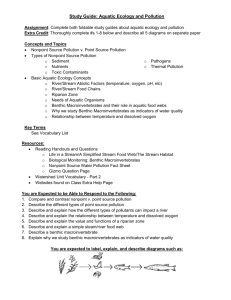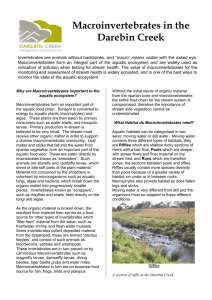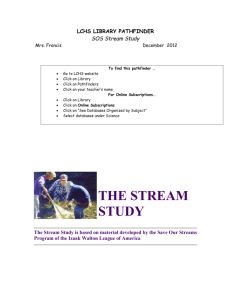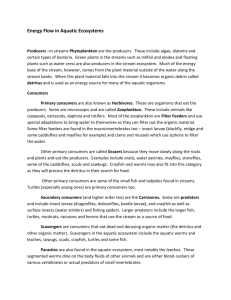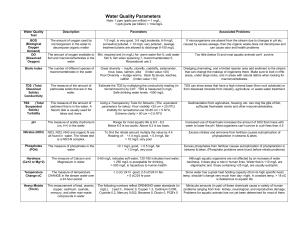Leaf pack analysis
advertisement
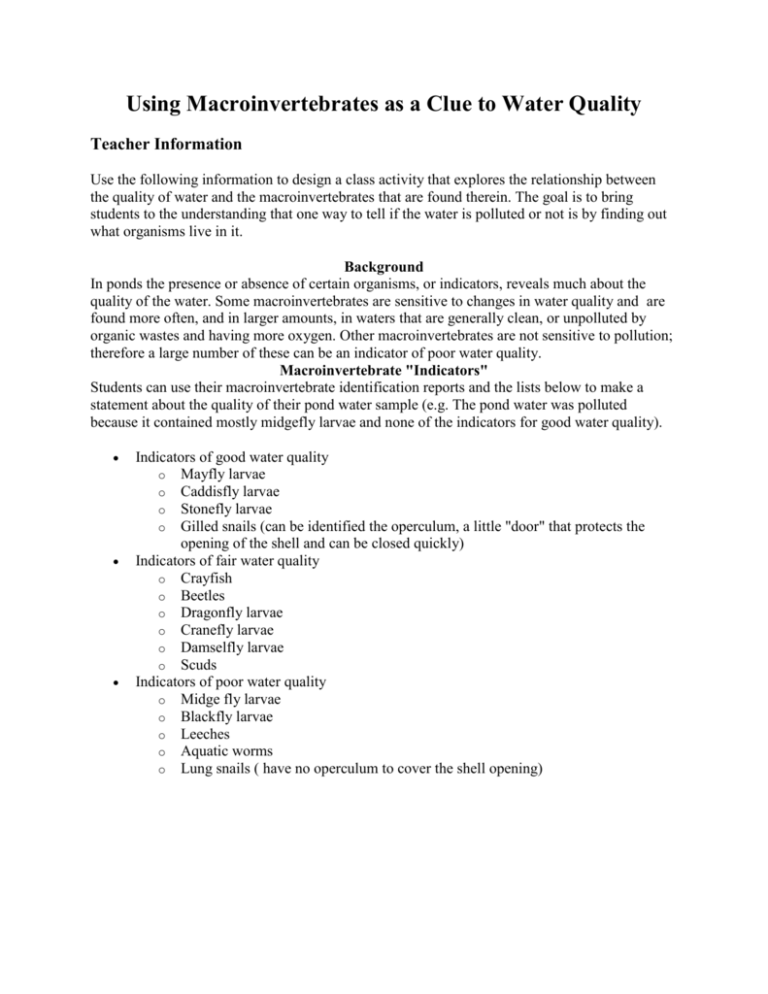
Using Macroinvertebrates as a Clue to Water Quality Teacher Information Use the following information to design a class activity that explores the relationship between the quality of water and the macroinvertebrates that are found therein. The goal is to bring students to the understanding that one way to tell if the water is polluted or not is by finding out what organisms live in it. Background In ponds the presence or absence of certain organisms, or indicators, reveals much about the quality of the water. Some macroinvertebrates are sensitive to changes in water quality and are found more often, and in larger amounts, in waters that are generally clean, or unpolluted by organic wastes and having more oxygen. Other macroinvertebrates are not sensitive to pollution; therefore a large number of these can be an indicator of poor water quality. Macroinvertebrate "Indicators" Students can use their macroinvertebrate identification reports and the lists below to make a statement about the quality of their pond water sample (e.g. The pond water was polluted because it contained mostly midgefly larvae and none of the indicators for good water quality). Indicators of good water quality o Mayfly larvae o Caddisfly larvae o Stonefly larvae o Gilled snails (can be identified the operculum, a little "door" that protects the opening of the shell and can be closed quickly) Indicators of fair water quality o Crayfish o Beetles o Dragonfly larvae o Cranefly larvae o Damselfly larvae o Scuds Indicators of poor water quality o Midge fly larvae o Blackfly larvae o Leeches o Aquatic worms o Lung snails ( have no operculum to cover the shell opening) Invertebrates as Indicators More about: Benthos Benthos Benthos Benthos Benthos in our waters identification classification life cycle as indicators Aquatic invertebrates live in the bottom parts of our waters. They are also called benthic macroinvertebrates, or benthos, (benthic = bottom, macro = large, invertebrate = animal without a backbone) and make good indicators of watershed health because they: live in the water for all or most of their life stay in areas suitable for their survival are easy to collect differ in their tolerance to amount and types of pollution are easy to identify in a laboratory often live for more than one year have limited mobility are integrators of environmental condition Some benthos are found more often, and in larger amounts, in waters that are generally clean, or unpolluted by organic wastes. Without too much organic matter, the waters usually have lots of oxygen for the benthos. This use as an "indicator" of water quality has been occurring for many years. For example, stoneflies are often considered to be clean water benthos. But when thinking about worms and midges, water quality professionals often view these as indicators of dirty water, especially in rivers and streams. Unfortunately, it is not always a clear decision to make. Oxygen is only one factor affecting the benthos. Others include toxic chemicals, nutrients, and habitat quality. Some types of stoneflies may actually be found in waters that are not so clean, and likewise some types of worms and midges can be found in cleaner waters. So it is important to understand that there are some more complex methods to make these types of decisions, and to determine whether waters are healthy or polluted for aquatic life. Depending upon the type of aquatic environment, such as standing waters like lakes and wetlands, the categories of clean, somewhat pollution tolerant, and pollution tolerant don't necessarily apply. Bugs as Indicators of Water Quality In Florida, we use aquatic macroinvertebrates, or "bugs", to help us figure out how clean or dirty water is (to find out more, check out this poster on bugs). In order to use bugs as indicators of water quality, we need to develop a bug "index", or number, which will tell us about the bugs we've found. Think of an index as a grade, like you'd get on a test, where the higher the number is the better you've done or the better the water is. 1. Print out the bug id cards and cut them apart. 2. Shuffle them and place them face down on a table. 3. Pick five cards at random and turn them over. 4. Use the bug identification poster to identify what bugs you're looking at. If you have trouble understanding any of the words, look in a dictionary or check out this poster on bug parts 5. Write down the drop number (check out the three "drips" below to see what they look like) for each bug you've identified. 6. Add up your bug numbers, this is your bug score. 7. Good biologists always double-check their identifications, check yours too! 8. Want to know what your score means? Some bugs can't tolerate water pollution, we call these bugs pollution sensitive. Mayfly Caddisfly Water Penny Planarian Dobsonfly Stonefly Other bugs are less sensitive to pollution... Crayfish Clam Fishfly Sowbug Scud Riffle Beetle Larva Alderfly Cranefly Dragonfly Mussel Riffle Beetle Adult Whirligig Damselfly Some bugs can live in any kind of water. We call these bugs pollution tolerant. Leech Midge Aquatic Worm Gilled Snail Black Fly Lunged Snail Freshwater Pollution Animals as Indicators of Pollution. © John Blatchford Apr 3, 2007 Many invertebrates live in freshwater, and those that live in streams can be used to indicate water quality. Streams can become polluted by water entering from agricultural land or industrial sites, and the quality of the water will be reflected by the types of creatures that can survive. Some of the worms can manage in very heavily polluted water (Tubifex is a good example), while some of the insects require clean conditions. Macroinvertebrates. The larger freshwater invertebrates (macroinvertebrates) spend most of their time in the same part of the stream. They are numerous and easy to catch, and once caught and identified they can give clues to the pollution history of that particular part of the stream. By sampling different locations it is possible to locate the source of any polluting incident – upstream will not be damaged, but downstream will have been affected. Biotic Index. There is a general rule that better water has a larger number of different invertebrate species, and by counting the number of different types of creatures it is possible to get a rough idea of water quality. By going further and identifying each species found it is possible to quantify this information. It is possible to arrive at the Biotic Index. This is a figure which allows different stretches of water to be compared in an objective way. Chemical Analysis. The alternative way of studying water pollution is by direct chemical analysis, and while it will be specific about the nature of the pollutants it can only help when the stream actually contains them. Once the damage has swept downstream the water will be replaced, but the invertebrates living in the affected area will have been harmed, and they will take a long time to recover. This means that occasional sampling of stream macroinvertebrates can be used to discover pollution events that occurred in the past. Indicator Species. If you can recognise one or two of the ‘indicator species’ you will not have to go to the trouble of identifying all the other creatures. If Stonefly larvae are present then the water is good, if they are absent but there are still Mayfly larvae then the water is reasonable. If neither of these is present then there has probably been a problem and a more detailed study might be called for. Ads by Google Selenium? Solved. A successful & proven solution for Selenium removal. Contact us today! www.seleniumremoval.com Land Pollution One of the World's Most Toxic Industries. Watch this Documentary! www.Babelgum.com/Documentary Collecting Macroinvertebrates. You will need a net and a pair of waterproof boots. Most of the creatures you want live under stones so that kicking the stones around upstream of the net will dislodge them and allow the current to carry them downstream and into your net. (This is sensibly known as ‘Kick Sampling’!). Putting them into a white dish with a little water will rapidly show you what you have caught. Read more: http://fishinsects.suite101.com/article.cfm/freshwater_pollution#ixzz0Xh42dkDN What are freshwater macro-invertebrates? Freshwater benthic macroinvertebrates, or more simply "benthos", are animals without backbones that are larger than ½ millimeter (the size of a pencil dot). These animals live on rocks, logs, sediment, debris and aquatic plants during some period in their life. The benthos include crustaceans such as crayfish, mollusks such as clams and snails, aquatic worms and the immature forms of aquatic insects such as stonefly and mayfly nymphs. Where and when are freshwater benthic macroinvertebrates found? These animals are widespread in their distribution and can live on all bottom types, even on manmade objects. They can be found in hot springs, small ponds and large lakes. Some are even found in the soil beneath puddles. Many species of benthos are able to move around and expand their distribution by drifting with currents to a new location during the aquatic phase of their life or by flying to a new stream during their terrestrial phase. Most benthic species can be found throughout the year, but the largest numbers occur in the spring just before the reproductive period. In colder months, many species burrow deep within the mud or remain inactive on rock surfaces. Many aquatic insects undergo a complete metamorphosis - the transition from egg to larva to pupa and finally to adult. They remain in the water for most of their lives (typically one month to four years). After becoming adults, the majority of insects live for only a brief time, usually a few hours to a few days, while they locate mates and reproduce. Return to Top What is the ecological importance of benthic macroinvertebrates? Benthos is an important part of the food chain, especially for fish. Many invertebrates feed on algae and bacteria, which are on the lower end of the food chain. Some shred and eat leaves and other organic matter that enters the water. Because of their abundance and position as “middlemen” in the aquatic food chain, benthos plays a critical role in the natural flow of energy and nutrients. As benthic invertebrates die, they decay, leaving behind nutrients that are reused by aquatic plants and other animals in the food chain Return to Top What are the advantages of using the benthos to monitor water quality? Unlike fish, benthos cannot move around much so they are less able to escape the effects of sediment and other pollutants that diminish water quality. Therefore, benthos can give us reliable information on stream and lake water quality. Their long life cycles allow studies conducted by aquatic ecologists to determine any decline in environmental quality. Benthos represents an extremely diverse group of aquatic animals, and the large number of species possess a wide range of responses to stressors such as organic pollutants, sediments, and toxicants. Many benthic macroinvertebrates are long-lived, allowing detection of past pollution events such as pesticide spills and illegal dumping. How are the benthos sampled and analysed?Sampling is based on the type of aquatic habitat under study. In turbulent riffles (shallow areas with fast flows), the most commonly sampled stream habitat, various nets are used to capture benthos. The nets are secured and the water is stirred up causing the benthos to float down stream into the net. In slow moving or still water, a dip net is often used to sample shore areas under bank overhangs or tree roots. In ponds or lakes with soft mud bottoms, grab samplers may be used to collect benthos. Benthic communities can be used to monitor stream quality conditions over a broad area or they can be used to determine the effects of point source discharges from sources such as sewage treatment plants and factories. Ecologists who evaluate environmental quality using the benthos often consider the following characteristics of a benthic sample to be important indicators of stream, river or lake quality: 1. taxa richness: a measure of the number of different types of animals; greater taxa richness generally indicates better water quality. 2. pollution tolerance: many types of benthos are sensitive to pollutants such as metals and organic wastes. Mayflies, stoneflies, and caddisflies are generally intolerant of pollution. If a large number of these insect types are collected in a sample, the water quality in the stream is likely to be good. If only pollution-tolerant organisms such as non-biting midges and worms are found, the water is likely to be polluted. 3. functional groups: the presence or absences of certain feeding groups (such as scrapers and filterers) may indicate a disturbance in the food supply of the benthic animals in the stream and the possible effects of toxic chemicals.
